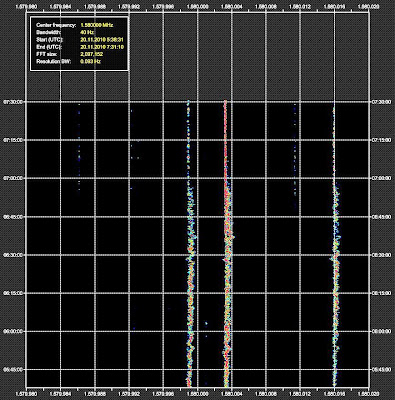
Japan on MW has been an interesting target for me since I started to listen to MW-signals from Asia. My first QTH in the Center of Finland was rather good for Asia during dark wintertimes.
In the era of reporting and QSL-hunting (70´s ... 80´s) I got about 30 QSL-cards and letters from Japanese MW-stations (NHK and commercial stations). Before the current mf-allocation they were pretty easy to hear on their 10 kHz spaced channels. It took about 20 years to get these 30 stations verified. I think in my old logbooks are about 40 stations heard. Some examples of the QSLs at the picture.
In December 2009 I tested how many of them can be heard in about month in this deep solar minumum. I recorded almost daily total mw-band at several TOH´s for 5-15 minutes (including several recordings around 1320 utc to get the NHK2-IDs). All recording were preprogrammed beforehand at my King´s Village QTH. Some days the program crashed because of the electricity problems (at rural areas there are sometimes short power blackouts - usually 1 seconds or so...) so there were some periods of several days without recording. I have now explored majority of the recordings. It seems conditions favoured Japan as was expected - during this deep minimum and almost total darkness even in Southern Finland, conditions towards North-West, North and North-East are going on daily. Example of these conditions is KUMU Hawaii which could be heard almost daily in Scandinavia.
The count of the stations heard from Japan (NHK´s partly IDed only as "NHK1/2", partly rather definite ID as being the only NHK on the channel). Commercial stations were IDed by the company initials (usually, as an example "KBC Radio" 1413 JOIF).
So during about 20 days recordings at around 11,12,13 and 14 UTC totally about 55 stations were heard. I could estimated that during the best days (like 8th December for example) one could get an ID of 30-40 stations during about 3 hours containing 4 recordings of 5 minutes each at the TOH and 1 minute at 1320 UTC! That is a difference - during 1900´s I had a TRIO 9R59DS receiver and some longwire antennas - now a Perseus SDR-receiver and a BOG antenna. So one can not compare the results of 1970´s - 1980´s to todays captures!
The list of the stations:
freq station remarks
567 JOIK NHK1, Sapporo no call id
594 JOAK NHK1, Tokyo/Shobu no call id
648 JOIG NHK1, Toyama no call id
666 JOBK NHK1, Osaka
693 JOAB NHK2, Tokyo/Shobu
729 JOCK NHK1, Nagoya no call id
747 JOIB NHK2, Sapporo no call id(*
774 JOUB NHK2, Akita
792 NHK1, tent. Embetsu (//Hokkaido NHK) no call id
828 JOBB NHK2, Osaka/Habikino
837 JOQK NHK1, Niigata no call id
864 JOXR ROK Radio Okinawa, Naha/Nanjo
873 JOGB NHK2, Kumamoto
927 NHK1
936 JOTR ABS Akita Hoso, Akita
954 JOKR TBS Tokyo Hoso, Tokyo/Toda
963 JOTG NHK1, Aomori local news
990 JORK NHK1, Kochi no call id
1008 JONR ABC Asahi Hoso, Kyoto
1017 JOLB NHK2, Fukuoka
1053 JOAR CBC Chubu-Nippon Hoso, Nagoya/Kuwana-Shi
1071 JOFK NHK1, Hiroshima no call id
1107 JOCF MBC Minami Nihon Hoso, Kagoshima
1107 JOMR MRO Hokoriku Hoso, Kanazawa
1116 JODR BSN Niigata Hoso, Niigata
1134 JOQR NCB Bunka Hoso, Tokyo/Kawaguchi
1179 JOOR MBS, Mainichi Hoso, Osaka
1197 JOFO RKB, RKB Mainichi Hoso, Kitakyushu Fukuoka
1224 JOJK NHK1, Kanazawa no call id
1233 JOUR NBC Nagasaki Hoso, Nagasaki
1233 JOGR RAB Aomori Hoso, Aomori
1242 JOLF NBS Nippon Hoso, Tokyo/Kisarazu
1260 JOIR TBC Tohoku Hoso, Sendai
1269 JOJR JRT Shikoku Hoso, Tokushima
1278 JOFR RKB Mainichi Hoso, Fukuoka
1287 JOHR HBC, Hokkaido Hoso, Sapporo
1314 JOUF OBC Radio Osaka, Osaka/Sakai-Shi
1332 JOSF Tokai Hoso, Nagoya
1368 JOHP NHK1, Takamatsu Kagawa no call id
1377 JOUC NHK2, Yamaguchi
1386 JOJB NHK2, Kanazawa
1386 JOKB NHK2, Okayama
1395 RKC, Kochi Hoso, Sukumo Kochi
1413 JOIF KBC-Kyushu Asahi Hoso, Fukuoka
1422 JORF RF, RF Radio Nippon, Yokohama
1431 JOZF GBS, Gifu Hoso, Gifu
1440 JOWF STV, Sapporo TV Hoso, Sapporo
1467 JOID NHK2, Oita / NHK2 Hokkaido (** no call id
1494 JOYR RSK, Sanyo Hoso, Okayama
1503 JOUK NHK1, Akita no call id
1512 JOZB NHK2, Matsuyama no call id
1521 JOTC NHK2, Aomori no call id
1584 JOQG NHK1, Fukaura Aomori no call id
1593 JOQB NHK2, Niigata
1602 JOSB NHK2, Kitakyushu Fukuoka
1602 NHK2, Embetsu //747 Sapporo
*) Sapporo NHK 747 nowadays no call at 1320 only "NHK"
**) poss. Different relays diff. Days, one day //Hokkaido channels
Ids: NHK usually at 1320 after the weather
Some NHK1 with local programs before 11 utc
Some NHK-stations "Ided" being the only one on the frequency
Commercial stations Ids with company inititials with some exceptions (like "Radio Kansai 1395")
56 stations logged Dec 1 - 31 2009 (updated list after check 15th Jan.)
Perseus sdr + 250 m BOG (under snow) to NE


















































